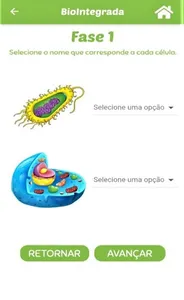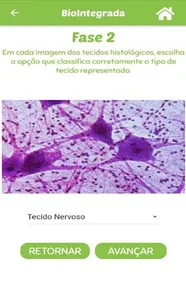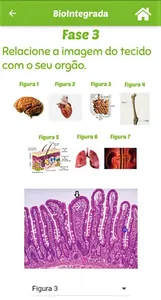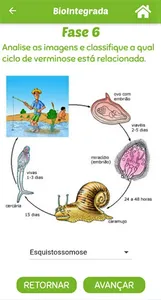The BioIntegrada game application was developed by professor Vaneria Maria Pinheiro Medeiros as a product to obtain the title of Master in Biology Teaching by PROFBIO - Professional Master in Biology Teaching in the National Network, with the guidance of Professor Dra. Andréa Pereira Silveira. Being defended in an examining board and approved on October 13, 2020.
It consists of eight phases, with the aim of correctly analyzing and relating the structures and moving on to the next challenge. Phases 1 to 5 are related to human morphology and deal with the hierarchy of life, from the microscopic to the macroscopic level: cells - tissues - organs - systems - organism. Phase 6 refers to some cycles of verminosis that has the human being as a host and shows the integration of this organism in the environment in which it is inserted. Phase 7, on the other hand, continues the hierarchy of life at an ecological level: population - community - ecosystem - biosphere. Ending in phase 8 with the completion of a questionnaire, the purpose of which is to encourage reflection on our actions in everyday situations.
The structuring of content in a sequenced manner ending with reflections of our actions in daily life, in a game application, has the potential to promote student involvement, stimulating autonomy, encouraging the development of critical thinking and the ability to understand the environment in which it's inserted. In this sense, in the button “SD” - Didactic sequence, there is a proposal for the teacher to use the game with students in the classroom based on the approach of Critical Environmental Education.
It consists of eight phases, with the aim of correctly analyzing and relating the structures and moving on to the next challenge. Phases 1 to 5 are related to human morphology and deal with the hierarchy of life, from the microscopic to the macroscopic level: cells - tissues - organs - systems - organism. Phase 6 refers to some cycles of verminosis that has the human being as a host and shows the integration of this organism in the environment in which it is inserted. Phase 7, on the other hand, continues the hierarchy of life at an ecological level: population - community - ecosystem - biosphere. Ending in phase 8 with the completion of a questionnaire, the purpose of which is to encourage reflection on our actions in everyday situations.
The structuring of content in a sequenced manner ending with reflections of our actions in daily life, in a game application, has the potential to promote student involvement, stimulating autonomy, encouraging the development of critical thinking and the ability to understand the environment in which it's inserted. In this sense, in the button “SD” - Didactic sequence, there is a proposal for the teacher to use the game with students in the classroom based on the approach of Critical Environmental Education.
Show More






